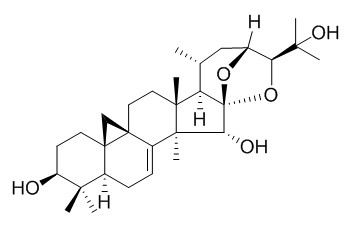7,8-Didehydrocimigenol
7,8-Didehydrocimigenol can be used for the treatment of cardiovascular disorders such as atherosclerosis. It upregulates PPAR-γ in EC inhibits NF-kB activity of TNF-α-activated EC which leads to selective inhibition of VCAM-1 expression.
Inquire / Order:
manager@chemfaces.com
Technical Inquiries:
service@chemfaces.com
Tel:
+86-27-84237783
Fax:
+86-27-84254680
Address:
1 Building, No. 83, CheCheng Rd., Wuhan Economic and Technological Development Zone, Wuhan, Hubei 430056, PRC
Providing storage is as stated on the product vial and the vial is kept tightly sealed, the product can be stored for up to
24 months(2-8C).
Wherever possible, you should prepare and use solutions on the same day. However, if you need to make up stock solutions in advance, we recommend that you store the solution as aliquots in tightly sealed vials at -20C. Generally, these will be useable for up to two weeks. Before use, and prior to opening the vial we recommend that you allow your product to equilibrate to room temperature for at least 1 hour.
Need more advice on solubility, usage and handling? Please email to: service@chemfaces.com
The packaging of the product may have turned upside down during transportation, resulting in the natural compounds adhering to the neck or cap of the vial. take the vial out of its packaging and gently shake to let the compounds fall to the bottom of the vial. for liquid products, centrifuge at 200-500 RPM to gather the liquid at the bottom of the vial. try to avoid loss or contamination during handling.
Journal of Third Military Medical University2018, 40(12):1073-1078
Cell Rep.2020, 32(11):108158.
Natural Product Communications2020, doi: 10.1177.
The Journal of Agromedicine and Medical Sciences2018, 4(1)
Exp Ther Med.2019, 18(6):4388-4396
Research Square2024, rs-4398438
Iranian J. Pharm. Res.2021, 20(4):59-70
Food Res Int.2018, 106:909-919
J Enzyme Inhib Med Chem.2019, 34(1):134-143
Phytochemistry2018, 15:83-92
Related and Featured Products
Food Chem Toxicol. 2011 Jan;49(1):166-72.
7,8-didehydrocimigenol from Cimicifugae rhizoma inhibits TNF-α-induced VCAM-1 but not ICAM-1expression through upregulation of PPAR-γ in human endothelial cells.[Pubmed:
20946932]
Activators of PPAR have been demonstrated to inhibit the induction of VCAM-1 but not ICAM-1 in human endothelial cells (EC). During the screening of anti-inflammatory activity of traditional herbs, we found 7,8-Didehydrocimigenol (7,8-DHC), one of active triterpenoids of Cimicifugae rhizoma (C. rhizoma) increases PPAR-γ expression in EC in a time- and dose-dependent manner.
METHODS AND RESULTS:
Therefore, we asked whether 7,8-Didehydrocimigenol selectively inhibits the expression of VCAM-1 but not ICAM-1 in TNF-α-activated EC via upregulation of PPAR-γ. Treatment with 7,8-Didehydrocimigenol or PPAR-γ agonists (GW1929, troglitazone) inhibited the expression of VCAM-1 but not ICAM-1. 7,8-Didehydrocimigenol significantly inhibited NF-kB activity via inhibition of phosphorylation of IkB and it also inhibited phosphorylation of ERK1/2 and Akt but not PKC. Finally, attachment of monocytes (U937) to EC by TNF-α was significantly reduced by 7,8-Didehydrocimigenol .
CONCLUSIONS:
These results indicate that upregualtion of PPAR-γ by 7,8-Didehydrocimigenol in EC inhibits NF-kB activity of TNF-α-activated EC which leads to selective inhibition of VCAM-1 expression. In addition, ERK1/2 and Akt signal pathways are involved in differential regulation by 7,8-Didehydrocimigenol. We concluded that 7,8-Didehydrocimigenol can be used for the treatment of cardiovascular disorders such as atherosclerosis.



